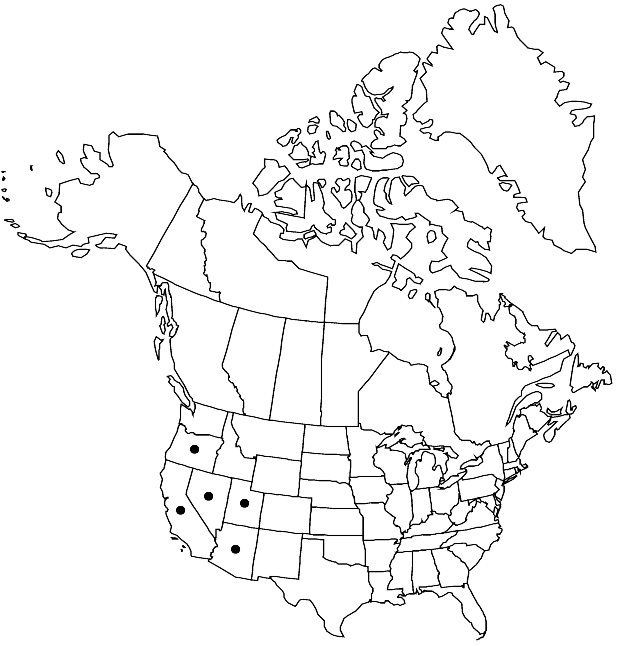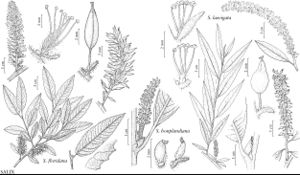Difference between revisions of "Salix laevigata"
Amer. Naturalist 8: 202. 1874.
FNA>Volume Importer |
FNA>Volume Importer |
(No difference)
| |
Revision as of 22:52, 16 December 2019
Trees, 2–15 m. Stems: branches flexible to highly brittle at base, gray-brown to yellow-brown, glabrous or villous; branchlets yellow-brown or red-brown, glabrous, densely villous, velvety, or pilose, nodes hairy. Leaves: stipules rudimentary grading into foliaceous or absent on early ones, usually foliaceous on late ones, apex acute, acuminate, rounded or convex; petiole (shallowly or deeply grooved adaxially, margins sometimes touching, sometimes with basilaminar glands, thickening), 3.5–18 mm, pubescent to glabrescent adaxially; largest medial blade lorate, narrowly oblong, narrowly elliptic, lanceolate, or obovate, 53–190 × 11–35 mm, 2.8–9 times as long as wide, base convex, subcordate, rounded, or cuneate, margins crenate, entire, or finely serrulate, apex acuminate, acute, or caudate, abaxial surface glabrous or pubescent, hairs spreading, white and/or ferruginous, adaxial highly or slightly glossy, glabrous or pubescent, midrib sometimes villous; proximal blade margins entire; juvenile blade glabrous or moderately densely long-silky to pilose abaxially, hairs white and/or ferruginous. Catkins: staminate 31–83 × 7–13 mm, flowering branchlet 2–26 mm; pistillate 28–79 × 6–11 mm, flowering branchlet 3–14 mm; floral bract 1.6–3.4 mm, apex rounded or acute, irregularly toothed or entire, abaxially sparsely to moderately densely hairy proximally or throughout, hairs wavy; pistillate bract deciduous after flowering. Staminate flowers: abaxial nectary 0.4–0.6 mm, adaxial nectary oblong, square, or ovate, 0.3–0.6 mm, nectaries distinct; stamens 3–7; filaments (sometimes basally connate), hairy on proximal 1/2 or basally; anthers 0.4–0.6 mm. Pistillate flowers: adaxial nectary square, 0.2–0.6 mm; stipe 1.4–2.8 mm; ovary pyriform, obturbinate, or ellipsoidal, beak slightly bulged below styles; ovules 12–24 per ovary; styles 0.1–0.2 mm; stigmas 0.2–0.23–0.28 mm. Capsules 3–5.5 mm.
Phenology: Flowering (Dec-)Feb or mid Apr-early Jun.
Habitat: Riparian forests along streams, seepage areas, springs, subalkaline or brackish lakeshores, canyons, ditches
Elevation: 0-2200 m
Distribution

Ariz., Calif., Nev., Oreg., Utah, Mexico (Baja California, Baja California Sur).
Discussion
Hybrids:
Salix laevigata forms natural hybrids with S. gooddingii.
Related Species:
Salix humboldtiana Willdenow: Humboldt willow is not known to occur in the flora area. It is characterized by: trees, 4–25 m; branches highly brittle at base, bud-scale margins distinct and overlapping adaxially; stipules on late leaves rudimentary or foliaceous; largest medial leaf blade usually linear, abaxial surface not glaucous, adaxial dull; pistillate bract deciduous after flowering; stamens 3–7; capsules with distinct, often raised, white veins. It occurs throughout much of Mexico to central Chile.
Salix humboldtiana is closely related to S. nigra in its generally narrow leaf blades, which are not glaucous abaxially. The two differ in the following characters: S. humboldtiana has leaf blades linear to sometimes narrowly oblong (10–28.6 times as long as wide), ovaries usually ovoid to ellipsoid, ovary walls often stomatiferous and with raised, white veins, and capsule valves relatively thick, slightly recurved. S. nigra has leaf blades usually narrowly lanceolate (6–13 times as long as wide), ovaries pyriform to obclavate, ovary walls neither stomatiferous nor notably veined, and capsule valves relatively thin and strongly recurved. Both species occur in Chihuahua, Mexico.
The report by R. I. Lonard et al. (1991) that specimens identified as Salix nigra from the lower Rio Grande, Texas, resemble S. humboldtiana in having strongly veined capsules suggests that S. humboldtiana, or intergrades with that species, may occur in Texas. Attempts to locate a voucher specimen were unsuccessful; because strongly veined capsules are diagnostic, further field study is indicated.
An earlier name, Salix chilensis Molina, has been applied to this species; it does not seem to pertain to this taxon (C. K. Schneider 1918).
Selected References
None.
